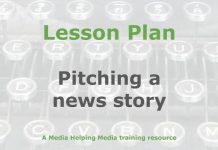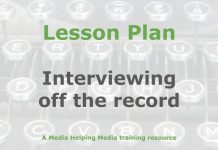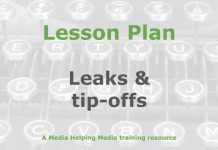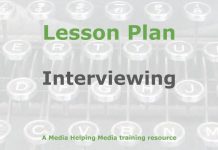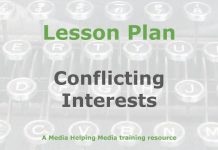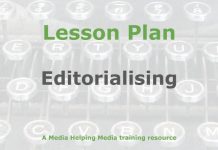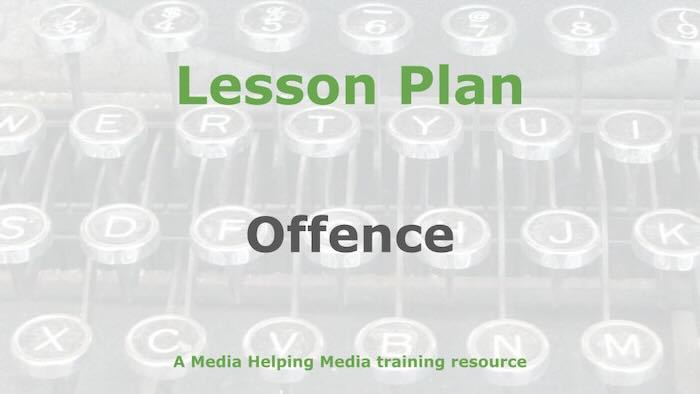 This lesson plan is designed to help students avoid causing unnecessary offence while continuing to produce robust, critical, in-depth journalism.
This lesson plan is designed to help students avoid causing unnecessary offence while continuing to produce robust, critical, in-depth journalism.
It’s based on the article ‘Offence and journalism‘ which is published on Media Helping Media. We recommend reading the piece before adapting this lesson plan for your own purposes.
Learning objective
Students will evaluate how news content can cause offence and ensure it has a clear editorial purpose. They will analyse the balance between media freedom and sensitivity to audience reactions.
- Student-facing objective: By the end of this lesson the student will be able to assess how news stories might offend people and explain why it’s important for journalists to have a clear reason for sharing such stories.
- Standards: Students will learn about how some news content could cause offence and ensure that it has a clear editorial purpose.
Learning activities
Warm-up
Begin with a brief discussion prompt: “Think of a time when you read or heard a news story that was controversial or offensive. What made it controversial or offensive?” Allow students a few minutes to reflect and jot down their thoughts. Then, ask them to share with a partner. Afterward, invite a few students to share their examples with the class. This will activate prior knowledge about media content and set the stage for analysing the balance between media freedom and audience sensitivity.
Direct instruction
- Conceptual understanding: Introduce the concept of editorial purpose. Explain that journalists must have a clear reason for including potentially offensive content. Use real-world examples, such as a news report on a violent protest, to illustrate how editorial purpose justifies the inclusion of graphic content. Discuss the importance of context and intent in journalism.
- Procedural skills and fluency: Present a case study of a controversial news story. Break down the editorial decisions made, focusing on how the journalists balanced offence with the need to inform. Guide students through identifying the editorial purpose and the potential for offence. Use a step-by-step analysis to demonstrate how journalists decide what content to include.
- Application: Assign a hypothetical scenario where students act as editors for a news outlet. Provide a brief description of a sensitive topic, such as a political scandal involving offensive language. Ask students to determine the editorial purpose and decide what content to include or exclude. Have them justify their decisions, considering both media freedom and audience sensitivity.
Guided practice
Think, Pair, Share: Guide students through a structured discussion to deepen understanding of editorial purpose and offence in journalism.
- Think: Pose the question, “How can journalists balance the need to inform with the potential to offend?”
- Pair: Have students pair up to discuss their thoughts. Encourage them to consider different perspectives and refine their ideas.
- Share: Invite pairs to share their insights with the class. Facilitate a discussion that highlights diverse viewpoints and reinforces the importance of editorial purpose.
- Connect: As students share, connect their ideas to the real-world examples discussed earlier. Emphasise how editorial decisions impact audience perception.
- Reflect: Conclude with a brief reflection. Ask students to write a sentence summarising their understanding of balancing offence and editorial purpose.
Independent practice
- Assign students to analyse a recent news article that contains potentially offensive content. Provide a list of articles to choose from.
- Instruct students to identify the editorial purpose of the article and evaluate how the journalists balanced offence with the need to inform.
- Ask students to write a brief analysis, focusing on:
- The editorial purpose of the article.
- The potential for offence and how it was addressed.
- Their opinion on whether the balance was effectively achieved.
Circulate to observe and support students as needed.
Assignment
Ask students to answer these questions :
- What is one reason journalists might include potentially offensive content in a news story?
- How can journalists ensure that offensive content serves a clear editorial purpose?
- What’s one question you still have from today’s lesson?
Here are some suggested answers:
- Suggested answer to Question 1: To provide a complete and accurate portrayal of events, ensuring the audience is fully informed.
- Suggested answer to Question 2: By clearly explaining the context and intent behind the content, and providing warnings if necessary.
Teacher resources
Differentiation guide
- Advanced learners: Encourage deeper analysis by having them explore the ethical implications of editorial decisions. Ask them to research a controversial news story and present a case study on how different media outlets handled the offence. Challenge them to propose alternative approaches that balance media freedom and audience sensitivity.
- Striving learners: Simplify the case study analysis by providing a guided worksheet with specific questions to answer. Pair them with peers for collaborative analysis. Offer additional examples of editorial purpose to reinforce understanding. Use visual aids to illustrate key concepts and facilitate comprehension.
- Background reading: This lesson plan is based on the article ‘Offence and journalism‘ which is published on Media Helping Media. We recommend reading the piece before adapting this lesson plan for your own purposes.
Notable definitions
- Editorial purpose: The clear and justified reason for including specific content in a news story, ensuring it serves the audience’s need for information while considering potential offence.
- Media freedom: The right of journalists to report news without censorship or restraint, balanced against the responsibility to avoid unnecessary offence.
- Offensive content: Material in news stories that may upset or disturb audiences, requiring careful consideration and justification for its inclusion.
Required materials
- Computers: For accessing news articles and conducting research.
- Projector: To display real-world examples and case studies.
- Printed articles: A selection of recent news articles with potentially offensive content.
- Worksheets: For guided analysis and reflection activities.
- Writing materials: Pens and paper for note-taking and reflections.
Lesson summary
- Warm-up
- Direct instruction
- Guided practice
- Independent practice
- Assignment
The free teaching tools at the Khan Academy were used as a basis for converting the original article into a lesson plan.
Related article

